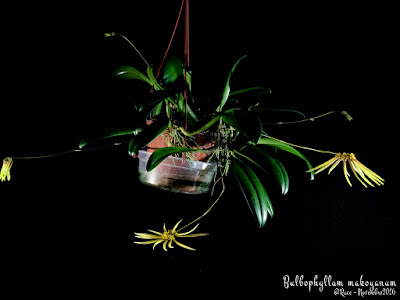The range of Bulbophyllum makoyanum is the Philippines, Borneo, Malaysia and isolated finds in Singapore. In the Philippines, this species grows on trees at low altitudes. In Borneo, it occurs in low-lying forests at heights of 100-200 m.
Bulbophyllum makoyanum, also called as Makoy's Cirrhopetalum (named in honor of the Belgian botanist Lambert Jacob-Makoy), Daisy Orchid, Cirrhopetalum makoyanum, is a species of the genus Bulbophyllum. This species was described by Ridley in 1879.
IDENTIFY BULBOPHYLLUM MAKOYANUM
Bulbophyllum makoyanum is native to Philippines, Borneo, Malaysia and single finds in Singapore. In the Philippines, they grow on trees, at low altitudes, on the island of Mindanao in the province of Agusan, on the island of Busuanga, on the island of Luzon in the provinces of Ifugao, Rizal and Zambales, and on the islands of Palawan and Polillo, east of the island of Luzon. In Borneo, they grow in lowland forests in Kalimantan at heights of 100-200 m.
It is a miniature to small sized, warm to hot growing, unifoliate epiphyte, which reaching 8 cm in height, that has 3/4" (2 cm) between each ovate, ridged with age pseudobulb, carrying a single, erect, narrowly ovoid, 7 cm long and 2 cm wide leaf that narrows below into a petiole.
Makoy's Cirrhopetalum blooms on a basal, slender, 8" (20 cm) long, purple, 5 to 12 flowered inflorescence that has an apical umbel of fragrant flowers held just beyond the leaf. The flowers have pale yellow outer petals with purple dots halfway down the base, and only a few dots on the narrow tip. The dorsal petal is reddish with darker dots and stripes and has tassels with yellow hairs along the edges. The inner coat flakes are reddish with darker dots and stripes and also have yellow hairs forming fringe on the edges. The lip is yellowish with delicate purple dots.
BULBOPHYLLUM MAKOYANUM CARE AND CULTURE
Cultural information should only be used as a guide, and should be to be adapted to suit you. Your physical location; where you grow your plants, how much time you have to devote to their care, and many other factors, will need to be taken into account. Only then can you decide on the cultural methods that best suit you and your plants.
Light:
Bulbophyllum makoyanum needs a light level of 12000-20000 lux. The conditions should be rather shady with filtered, diffused light. Plants should never be exposed to the direct rays of the midday sun and strong air movement should be ensured all the time.
Temperature:
It is a thermophilic plant. Throughout the year, the average day temperature is 29-32 ° C, and the average night temperature is 22-24 ° C, which gives a daily amplitude of 7-9 ° C.
Humidity:
This species needs a humidity level of 85-90% for most of the year and drops to around 80% for about 3 months at the end of winter and early spring.
Substrate, growing media:
Bulbophyllum makoyanum require excellent drainage and good air circulation around the roots, so they are usually planted in very flat pots or baskets and apply a very loose, quickly drying ground quite tightly packed around the roots. Different amounts of humectant additives, such as perlite or peat moss pieces, can be mixed with a basic material consisting of small to medium sized pieces of pine bark or tree fern. Tree fern fibers are preferred because they do not decompose as quickly as the bark.
Repotting:
This plant react very badly to any violations of the root ball. After dividing or repotting, the plants often return to their normal state for almost a year. If the substrate has not decomposed and the plant has outgrown the container, then the plant can be removed with the entire root ball and placed in a larger container, and then topped up with fresh medium. If repotting is necessary, it is best to do it when the new roots are already starting to grow, to allow the plant to root as quickly as possible. Plants should, however, be repotted immediately after finding out that the substrate has decomposed.
Watering:
Bulbophyllum makoyanum should be watered abundantly during periods of intensive growth, but excellent drainage should be ensured, and the ground around the roots can never be spread or soggy.
Fertilizer:
Plants should be fertilized every week 1/4-1/2 of the recommended dose of fertilizer for orchids. A fertilizer with a high nitrogen content is beneficial from spring to mid-summer, and a fertilizer richer in phosphorus should be used in late summer and autumn.
Rest period:
After Bulbophyllum makoyanum reaching new levels in autumn and winter, watering should be reduced to a certain extent, especially in the case of plants cultivated in darker conditions of a short day typical of higher latitudes, but they should not be completely deprived of water. When the amount of water decreases, fertilization should be reduced at the same time. In spring, when the growth of young growth begins, watering and fertilization increase.















COMMENTS